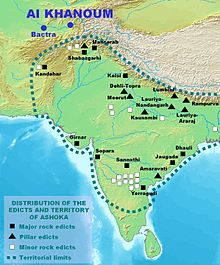Rock edicts of Khalsi
30°31′05″N 77°50′54″E / 30.5180°N 77.8482°E
| Rock edicts of Khalsi | |
|---|---|
Dehradun District, Uttarakhand, India | |

The Rock edicts of Khalsi, also spelled Kalsi, are a group of an Indian rock inscriptions written by the Indian Emperor
about 1850.The inscription
The Rock edicts of Khalsi are among the many inscriptions of Ashoka, the first being the
The Khalsi edicts, placed in North-Western India, were located near the Hellenistic world represented by the
The inscriptions were written on a solid
This last edict, Edict No.13, is particularly important in that it mentions the main Hellenistic kings of the time, as well as their precise geographical location, suggesting that Ashoka had a very good understanding of the Greek world of the time.[1] It is also this inscription which made it possible to date the reign of Ashoka with a certain precision, between 260 and 230 BCE.[1] This Edict also appears, although in a less well preserved form, in the Girnar inscription,[6] and very damaged in the Mansehra inscription.[7]
-
Shelter of the inscription nowadays.
-
The edicts from 1 to 12, and beginning of edict N°13.
-
The Elephant motif, and continuation of edict N°13.
-
Continuation of Edict No13 of the Khalsi inscription.
Edict 13 refers in particular to contemporary rulers of the
Now, it is the conquest by the Dharma that the Beloved of the Gods considers as the best conquest. And this one (the conquest by the Dharma) was won here, on the borders, and even 600
Pandyas, and as far as Tamraparni— Extract from Edict No.13.[9]
Some scholars believe that Buddhist communities have emerged in the Hellenistic world following Ashoka's reign, notably in Alexandria (this community being mentioned four centuries later by Clement of Alexandria). Given Ashoka's particularly moral definition of "Dharma" it is possible that he simply wants to say that virtue and piety now exist from the Mediterranean to the south of India. An expansion of Buddhism to the West is unconfirmed historically. In other inscriptions, Ashoka also states that he sent emissaries to the West to transmit medical care and medicinal plants (Major Rock Edict No.2). We do not know what the influence of these emissaries was on the Greek world.
Stamping
The inscriptions have been remarkably stamped and published by E. Hultzsch in "Inscriptions Of Asoka", the full text of which is available online.[10]
-
Stamping of the inscription: Edicts from 1 to 12, and beginning of 13.
-
Stamping of the south portion of the inscription. Continuation of Edict 13, and Edict 14.
-
The Elephant.
Relation to Greek philosophy
According to Valeri Yailenko, the Kineas inscription of
References
- ^ a b c d e f g h i Yailenko 1990, pp.239-256
- ^ "Archaeological Survey of India Dehradun Circle -Dehradun". www.asidehraduncircle.in. Retrieved 2022-09-17.
- ^ a b Inscriptions of Asoka by Alexander Cunningham, Eugen Hultzsch, 1877 pp.15-16
- ISBN 978-0-19-802673-0.
- ^ S.Dhammika, The Edicts of Ashoka King The Fourteen Rock Edicts / 13
- ^ Inscriptions Of Asoka, E.Hultzsch, 1925 p.25
- ^ Inscriptions Of Asoka, E. Hultzsch, 1925 p.83
- ^ VP Yailenko, "Aï Khanoum's Delphic Maxims and the Formation of Asoka's Dharma Doctrine", in: Ancient History Dialogues, 1990, volume 16, number 1, pp.239-256
- ^ S.Dhammika, The Edicts of King Ashoka The Fourteen Rock Edicts/13
- ^ Inscriptions Of Asoka, E.Hultzsch, 1925 Full text
Sources
- Valeri P. Yailenko, Aï Khanoum's delphic maxims and the formation of the Asoka dharma doctrine, Dialogues d'histoire ancienne, volume 16, number 1, 1990, 239-256








